Tharp's Thoughts Weekly Newsletter (View On-Line)
-
Article I Can't Believe It's Not Cyclicals by D.R. Barton, Jr.
-
-
Trading Tip Have a Position Sizing Strategy Idea? A Contest... by R.J. Hixson
-
Ken's Class You Can Check the News or Trade the Move by Ken Long
-
Three Workshops in Germany This September!
The Van Tharp Institute is bringing 3 workshops to Berlin, Germany this coming September. We will be offering How to Develop a Winning Trading System, Blueprint for Trading Success and Forex Trading. Register now to secure your $700 early enrollment discount!
Click here to learn more...
 I Can’t Believe It’s Not Cyclicals! I Can’t Believe It’s Not Cyclicals!
This Tentative Bull Market
by D.R. Barton, Jr.
View On-line
The best advertisers have a talent for making a phrase (one that is hopefully associated with their product or service) stick in our minds. For fun, let’s see how well they’ve done. Please fill in the blank for these popular advertising catch phrases (extra credit if you get the associated product):
- “Melts in your mouth, not __ ____ ___”
- “Breakfast of _________”
- “Good to the Last ____”
- “Plop, Plop, Fizz, Fizz, — __ ____ _ ______ __ __”
- “I Can’t Believe It’s Not ______”
Answers are at the bottom of the article (my apologies to those outside the U.S., though I’m sure there are advertising slogans in your country that are equally as memorable!).
The last slogan I listed came to mind when I was doing some sector research recently. “I Can’t Believe It’s Not Butter” is (cleverly) both the margarine’s brand name and catch phrase. The commercials for the butter substitute include various celebrities tasting the margarine and exclaiming incredulously—well, you know. (Obviously none of them were cooks…)
While doing my routine stock scans over the last few weeks, I noticed with the same level of incredulity as those celebrity margarine tasters that traditional defensive stocks, indeed whole defensive sectors, were outperforming the usual stocks that lead the pack in up trends. Cyclical sectors that usually go gangbusters in bull markets like technology, industrials, financial and energy have been lagging considerably behind the staid old defensive sectors. Let’s take a look at what is happening, dig into why, and then see if we can draw any sensible conclusions about where this could take us from here in terms of market direction.
Could These Sectors Possibly Lead the Bull Market Charge?
By definition, cyclical stocks and sectors are supposed to go up (or outperform) when the economy is strong and the stock market is in a bull phase. Counter-cyclical or defensive stocks and sectors are supposed to perform relatively better in down economic cycles and bear runs. Any analyst would see health care, utilities and consumer staples as classic defensive or counter-cyclical sectors. We can see the strong relative performance as expected with these defensive sectors in the last bear market from October 2007 to the low in March, 2009:
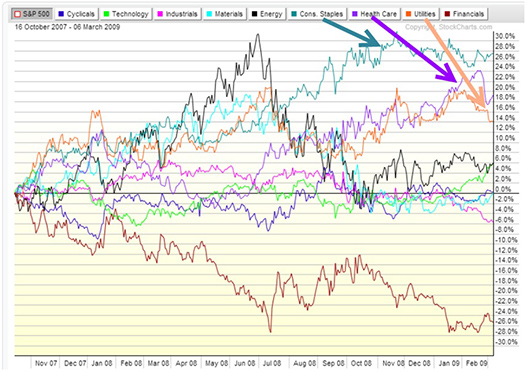
This chart was made using stockcharts.com’s Performance Charts and shows the performance of the various sectors RELATIVE to the S&P 500; all the sectors were down on an absolute basis during that period, but the top sectors in this chart show that they dropped less than the S&P or outperformed the index. And the leaders over that perilous time frame? Consumer staples, health care, and utilities.
We would expect the opposite to take place in the big raging bulls — these defensive stocks should swoon while the cyclical sectors should dominate. Let’s look at the two big rallies from the recent past — first, the grinding bull that followed the collapse of the internet bubble. This bull wound on from March of 2003 until October of 2007. The sectors’ performances during that time frame (again, relative to the S&P) looked like this:
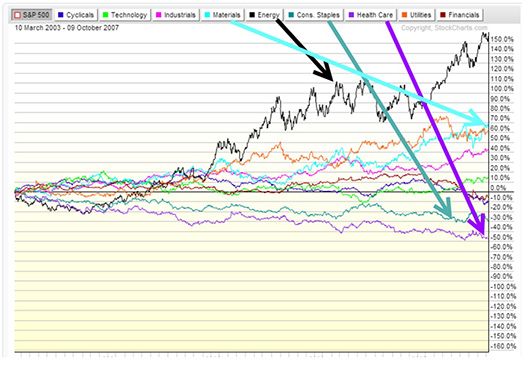
Here, we can see that energy clearly led the pack, (although much of this outperformance was due to geopolitical tensions driving up crude prices) and materials followed. The laggards, as expected were health care and consumer staples.
Now let’s look at what happened from the March 2009 bottom up until the September 2012 intermediate top:
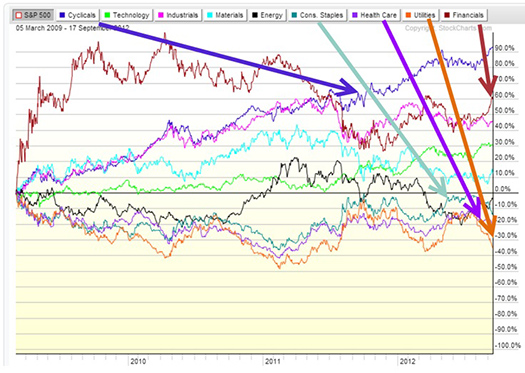
This time, the consumer discretionary led the way (XLY, labeled as Cyclicals by stockcharts.com), Financials came in second with industrials and technology following strongly. The laggards in this up cycle were the usual suspects: utilities at the bottom, along with health care and consumer staples.
This Year’s Tentative Bull – The Cyclicality Turns Upside Down for a Few Months
Since the beginning of 2013, we’ve entered the new, “post U.S. budget crisis” bull. While this bull has been persistent (the biggest pullback we’ve gotten since November of 2012 has been a mild 4.1% in the S&P), it has always had detractors that have expected a correction to come any day.
I’ve called this the “tentative bull” because the traditional sectors are no longer leading the way; in fact, they’re lagging. The defensive sectors are leading the charge, and by a wide margin. Here’s the same performance chart set out from the beginning of 2013 to this last week:
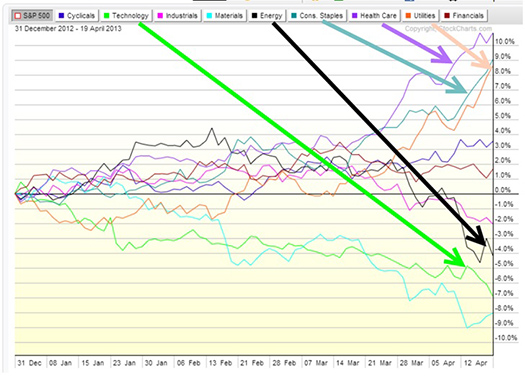
As we can see, health care has outperformed an already strong S&P by more than 10 percent! Consumer staples and utilities are not far behind. And all three of these far out distance the “also ran’s” — consumer discretionary and financials, which outperformed the S&P by rather modest amounts.
The flip side? Materials, technology, energy and industrials have all underperformed the S&P. What gives? This is incredibly non-traditional behavior for a strong bull market. And now for the final chart. I tried to quickly think of a few defensive individual stocks – the ones people turn to when times are bad. I thought of Walmart, Coca-Cola, McDonalds and Proctor & Gamble (maker of Tide and many other consumer staples) — four monster brands that tend to keep (or grow) their consumer base when times get tough. Here’s the relative performance chart of those four companies and the S&P that you would not expect to see in a strong bull:
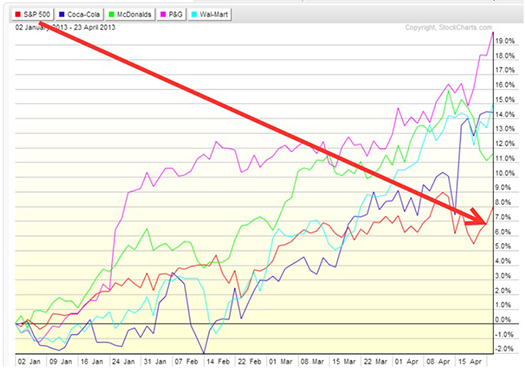
This chart shows these defensive stocks outperforming the benchmark S&P index since the beginning of the year. Try to understand how unusual this is — three of these four stocks significantly underperformed the S&P during the bull run from March 2009 to September 2012 - McDonalds outperformed by a small amount. Similarly, the same three stocks (except McDonalds again) underperformed the S&P during the 2003 — 2007 bull run.
So What Does All Of This Mean?
When the defensive stocks lead the charge on a bull run and the “risk on” stocks under-perform, we might be getting a glimpse into the thought process of investors and traders.
The best explanation that I have heard goes something like this:
- The market has had a strong run at the end of very long bull recovery. This up market has lasted more than four years. Despite the advanced age of this rally, money managers can’t afford to get cautious and lag behind the benchmark S&P by only being partially invested.
- Since managers are concerned that the market is overdue for a correction, those who have to put new money to work are choosing defensive names so that their portfolios would take less of a hit when the pullback finally comes.
- All of this money going into defensive names is driving up traditionally weak bull market performers and attracting money into those stocks and sectors, driving their prices up even further.
These factors have led to “risk on” or cyclical sectors underperformance. If the bulls can prolong the current up market, then money managers could once again become “true believers” in a longer-term bull and start rotating back into cyclical names — a move that could propel us even higher before that long-awaited correction comes. The Federal Reserve’s ultra-loose monetary policy (combined with the same strategy at the Bank of Japan, the European Central Bank, etc.) has only added fuel to the fire. This excess stimulus will almost certainly lead to a serious market accident — but not until the market has trapped the maximum amount of money. That will probably take another new high (or three) to get every cent back into the equities game that’s still on the sidelines for now.
Current economic and corporate earnings numbers in the U.S. aren’t helping much – they continue to be a mixed bag — some good news and some bad. Global equities markets continue to lag behind the aging bull in the U.S. (the notable exception being Japan). Emerging markets and China are especially weak. These dynamics will keep money managers driving with one foot on the gas pedal — they are trying to go as fast as they can, while the other foot is on the brake in anticipation of a sudden drop. As individual investors and traders, we need to keep alert for the signs of breakdown but we also need to remember that the U.S. indexes are still in grinding bull mode until further notice. If the 2003 — 2007 bull run taught us anything, it’s that a free-spending Fed can keep the party going long after signs point to problems on the horizon.
If you’ve found this article useful or thought provoking (or both), I’d love to hear your thoughts and feedback — just send an email to drbarton “at” vantharp.com.
Great Trading,
D. R.
P.S. — For those of you who never bought that gazillion-inch flat screen, here are the answers to the product catch phrases and their associated product:
- “Melts in your mouth, not in your hand” (M&M candy)
- “Breakfast of Champions” (Wheaties cereal)
- “Good to the Last Drop” (Maxwell House coffee)
- “Plop, Plop, Fizz, Fizz — Oh What a Relief It Is” (Alka Seltzer effervescent tablets)
- “I Can’t Believe It’s Not Butter” (margarine)
About the Author: A passion for the systematic approach to the markets and lifelong love of teaching and learning have propelled D.R. Barton, Jr. to the top of the investment and trading arena. He is a regularly featured guest on both Report on Business TV, and WTOP News Radio in Washington, D.C., and has been a guest on Bloomberg Radio. His articles have appeared on SmartMoney.com and Financial Advisor magazine. You may contact D.R. at "drbarton" at "vantharp.com".
Disclaimer
Trading Education
Why Don't You Trade Forex?
- "I’m too small to trade against the mega banks & hedge funds"
- "It’s a 24 hour market - I have to work and sleep some time!"
- "I can’t keep up with all the macro economic trends for the economies of the world."
- "I don’t even know half the currencies out there, how could I trade them?"
Here Are the Realities:
- The currencies market is the most liquid market in the world.
- It’s easily accessible and tradable by individuals today.
- Forex does not require huge amounts of capital to trade.
- The technical aspects of trading Forex are much more similar to trading equities or futures than they are different.
Don’t believe that last point? Take this test and see for yourself.
May 17-19 |
Swing Trading with Ken Long
Only a few seats remain.
|
May 21-23 |
Forex Trading with Gabriel Grammatidis
If you missed the Forex Article, click here
|
June 20-22 |
Peak Performance 101 - Sold Out
More dates to be announced soon for October |
July 13-14 |
Core Trading Systems
Longer Term Trading Systems from Ken Long
|
| July 20-21 |
Oneness Awakening Weekend
Just announced! |
To see the schedule, including dates, prices, combo discounts and location, click here.
It is confirmed! Van will bring three VTI Workshops to Berlin this Fall Including Forex Systems with Gabriel.
| Berlin, Germany Workshops |
September 6-8 |
How to Develop a Winning Trading System
with Van Tharp and RJ Hixson
|
September 10-12 |
Blueprint for Trading Success
with Van Tharp and RJ Hixson
|
September 14-16 |
Forex Trading
with Gabriel Grammatidis
|
Register for all 3 and save $800!
Trading Tip
Two Useful Position Sizing Strategies, Plus A Contest!
by R.J. Hixson
View On-line
Have a Position Sizing Strategy Idea? A Contest.
It’s been about five years since Van published his book, The Definitive Guide to Position Sizing Strategies, and he’s in the process of updating it this year. We just ran out of stock of the first edition so he’s hard at work, hoping to make the new edition available in the next few months. To help improve the book, we would like to make an offer to anyone who has an innovative position sizing™ strategy not mentioned in the book.
The first edition of the book had nearly 30 position sizing methods and three equity models which offered more than 90 position sizing strategies. With even the slightest modifications to each of those, however, the figure of possible strategies expands to a near-infinite number. Even still, people have submitted ideas that Van did not know about when he first wrote the book.
Here are two examples:
1. The Two Basket Method
One of the Super Traders developed this idea several years ago and shared it with Van. Say you were willing to be very aggressive with a certain portion of your money, but wanted to remain conservative with the rest. You would be willing to lose the total amount of the risk “basket” in order to achieve a very high return, but even if you did lose it all, you still have enough of your starting capital in your conservative "basket" to start over with a substantial sum.
For this method, the first step would be to define the maximum drawdown you would be willing to tolerate. For example, let’s say you would be willing to endure a 40% drawdown. You would then split your money into two theoretical “baskets” – a conservative basket with 60% of your equity and the risky basket with other 40%. You would then determine the optimal risk amount to meet your returns objectives and the optimal risk amount to avoid your biggest drawdown. For ease of demonstration, let’s say those two figures would be 1% for your returns objective and .2% for your drawdown avoidance objective. You would then risk 1% of your total equity amount on the trade, but you would split that unequally between the two baskets — .2% of your equity from the more conservative basket and the remaining .8% from your riskier basket portion of your equity.
This strategy would draw down your riskier basket more aggressively but, at the same time, increase it just as aggressively. As with a market’s money strategy, you would have to determine at what point you would rebalance your two classifications of equity and convert some portion of your riskier basket amount into your more conservative basket.
2. Double Up After Every Win
Van’s research assistant, Frank Eaves, came up with this next idea after playing the Position Sizing Game hundreds of times. He went on to test the idea in a simulator to find it worked surprisingly well. The idea is straightforward — for every trade that earns a profit, you simply add the earnings from that trade to the normal risk amount for the next trade. Whether that second trade earns a profit or sustains a loss, you go back to the original risk amount for the trade after that.
When the double-up trade loses, it loses both the earnings from the first trade and the risk amount from the second trade. Over the two trades, you scratch. If, however, the second trade earns a profit, it earns double. The strategy earned a spot in the new edition because, for all of its simplicity, the results of this strategy applied to several trading systems’ distributions were excellent.
Your Turn
We know we have creative, innovative clients who, no doubt, use position sizing methods that could be useful to other traders. If you are willing to share a great position sizing idea, we’d be willing to attribute the idea to you in the new edition and also give you a free copy of the book when it comes out later this year. You would need to provide a brief (or complex) explanation of how your position sizing strategy works and email that to positionsizing “at” vantharp.com by May 8, 2013.
While we would welcome any entirely new position sizing strategies not mentioned in the book, we would also welcome any innovative position sizing implementations for strategies in the book. The market’s money method specifically offers a lot of flexibility for traders who can conceive creative mathematical algorithms on how and when to convert market’s money into equity. The best ideas will make it into the new edition of the book and could earn you fame and fortune. (Well, at least acknowledgment and a free copy of the new book.)
Good luck!
About the Author: R.J. Hixson is a devoted husband and active father. At the Van Tharp Institute, he researches and develops new products and services that help traders trade better. In the last two months, he has walked more than 60 miles on his treadmill desk. He can be contacted at “rj” at “vantharp.com”.
Ken's Class
Live Day Trading Workshop Update —
“You Can Check the News or Trade the Move”
We have about twenty traders in the Live Day Trading Workshop this week. Yesterday, a number of people were out of the room eating lunch when the market dove down just after 1PM to Monday’s closing price. One of the traders in the room noticed major movement in a volatility issue but the S&P futures lagged so he shorted the S&P immediately to then cover shortly later for a nice winning trade. Several of the traders in Ken’s chatroom also profitably traded the event because they had seen movements like this before. There have been lots of strategy conversations over the last year about how to trade Fed announcements which generate similar signals. Having had those discussions and worked through the strategy, some of the chat room members were able to take quick advantage of the circumstances and make winning trades.
In the workshop room, some people were wondering what was going on in the news while Ken talked through and demonstrated how an adept trader might react. You can read his comments and see his results the summary below —
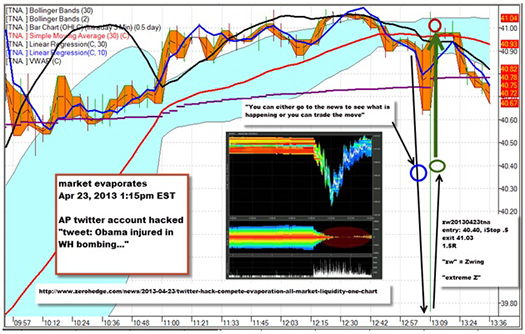
(To see a larger version, click on the picture.)
In this related video, Ken goes into some of the preparation for the day, reviews the Twitter mini crash, an provides a view at his daily report which points out swing opportunities in several issues.
Click Here to Watch the Video
News from Van
Updates to the Super Trader Program
The Super Trader Program will have a new pricing structure, beginning this July. For more information, click here.
 You Can Now Buy Van's New Book, Trading Beyond the Matrix Directly from VTI You Can Now Buy Van's New Book, Trading Beyond the Matrix Directly from VTI
Do You Have a Matrix Story? Since the release of Van's new book, Trading Beyond the Matrix, we have been hearing amazing stories about how the book is changing people's lives. We want to add a new section to the newsletter featuring these stories. If you have a story you would like to share, please email us at [email protected].
For more information, click here.
To purchase Trading Beyond the Matrix for $29.95, click here.
Podcasts and Interviews Featuring Dr. Van Tharp
Lately, Van has been talking about his new book, Trading Beyond the Matrix on various radio shows and podcasts. We have archived these and past interviews here so that you can listen!
Ask Van...
Everything we do here at the Van Tharp Institute is focused on helping you improve as a trader and investor. Consequently, we love to get your feedback, both positive and negative!
Click here to take our quick, 6-question survey.
Also, send comments or ask Van a question by clicking here.
Back to Top
Contact Us
Email us at [email protected]
The Van Tharp Institute does not support spamming in any way, shape or form. This is a subscription based newsletter.
To change your e-mail Address, e-mail us at [email protected].
To stop your subscription, click on the "unsubscribe" link at the bottom left-hand corner of this email.
How are we doing? Give us your feedback! Click here to take our quick survey.
800-385-4486 * 919-466-0043 * Fax 919-466-0408
SQN® and the System Quality Number® are registered trademarks of the Van Tharp Institute
Be sure to check us out on Facebook and Twitter!
 
Back to Top |